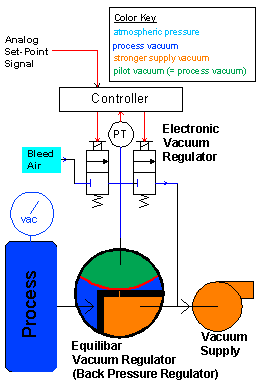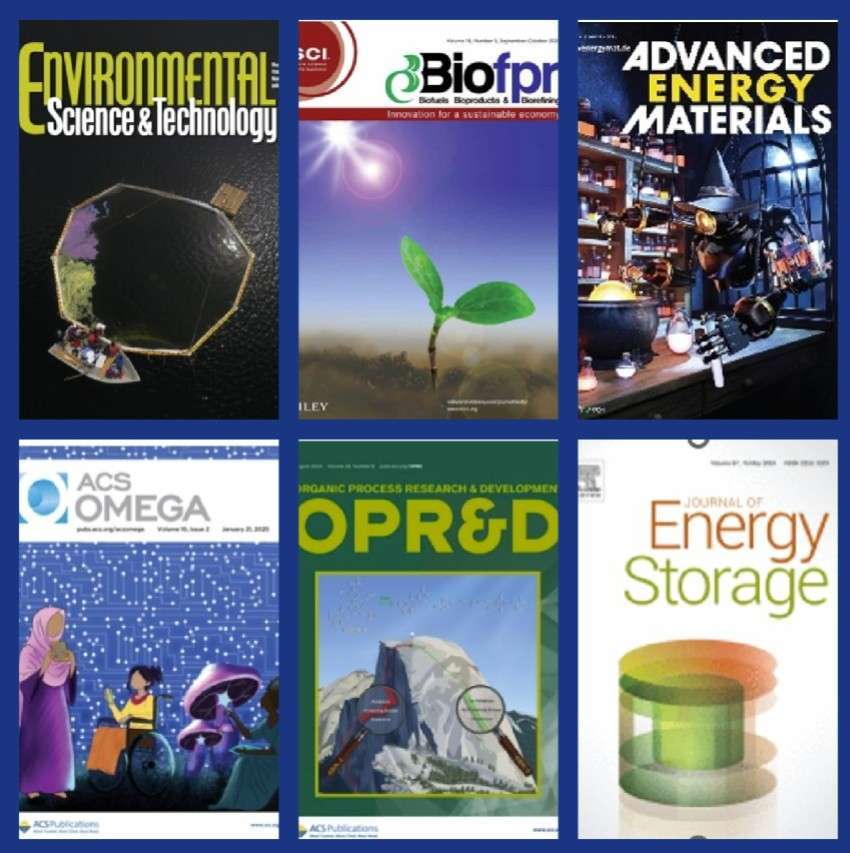To understand the basic purpose of a vacuum regulator compared to a vacuum breaker, see definition of a vacuum regulator page.
The difference in how the Equilibar vacuum regulator works
The design of the EVR can be described as a 2-stage vacuum regulator.
Stage 1: Small Setpoint Regulator
The first stage consists of a small sensitive vacuum regulator which generates a precise setpoint pressure that is equal to the desired process vacuum. This small regulator, also called a vacuum pilot regulator, is energized by the vacuum supply provided to the outlet port of the larger EVR regulator.
This small regulator also allows a very small amount of air to be drawn into it as a bleed to allow for reductions in vacuum setpoint. The setpoint regulator can be electronic or manual.
Stage 2: Volume Boosting Regulator
The larger regulator uses Equilibar’s unique direct sealing diaphragm technology to closely match the process inlet pressure to the pressure provided on its dome (by the small setpoint pilot regulator). This second stage serves as an ultra sensitive volume booster. It also provides chemical isolation between potentially aggressive process vapors and the smaller setpoint regulator.
This volume boosting stage is actually a dome-loaded back pressure regulator. A special diaphragm blocks the entrance to the process orifices, preventing the vacuum pump from drawing down the process below the setpoint pressure on the dome. Once the process pressure increases above the setpoint pressure, gas lifts up the special diaphragm and flows though to the regulator outlet.
The EVR directly controls vacuum pressure by throttling flow between the vacuum supply pump and the process in order to precisely control the process vacuum to a specific setpoint. The EVR is a non-relieving regulator intended for processes where at least a very small gas flow is present at all times.
Using an Electronic Pilot Setpoint Regulator
For computer automation, it is easy to use an electronic vacuum setpoint regulator in place of the manual vacuum setpoint regulator.
Electronic vacuum regulators have two servo valves that quickly open and close to control vacuum measured by a small internal pressure transmitter. They work just like electronic pressure regulators, except that ambient air is used on the inlet valve, and a vacuum supply is connected to the outlet valve.
More information about electronic pressure setpoint regulators can be found at this page. Moredetails about automated vacuum control are discussed on this page.
Overall Performance
The combination of these two stages provides a very stable vacuum pressure even as gas flow rates and vacuum supply pressures vary. Starting at $600, the Equilibar vacuum regulator is a good option for many complex vacuum applications where conventional, lower-cost solutions have not worked.
It should be noted that this vacuum regulator is a non-relieving non-bleeding type, and is not capable of rapidly increasing the pressure on the inlet port. The regulator is intended for processes where at least a very small gas flow is present at all times. If your process is gas-tight, with periods of near zero flow, your application engineer can discuss with you easy methods of providing a small gas bleed at the inlet of the regulator.
Equilibar Vacuum Regulators use a two-stage design, with a setpoint regulator on top, and a larger volume boosting EVR stage below.

A small vacuum regulator works to generate a set-point signal for a larger vacuum regulator (used as a volume booster).
A small electronic vacuum regulator works to supply the set-point signal for the larger vacuum regulator.




